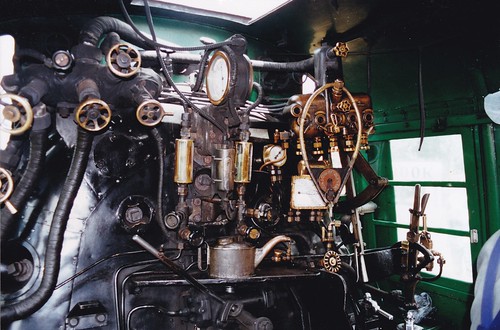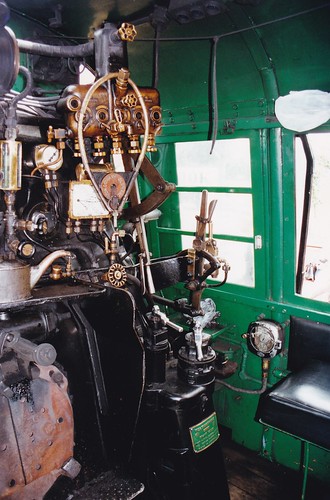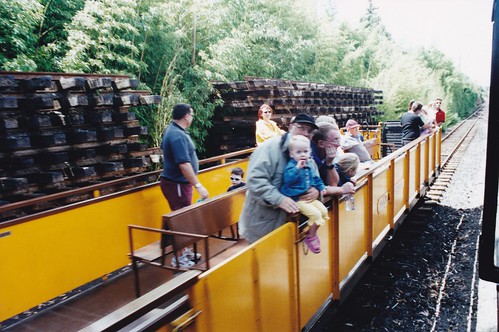During my time in Auckland on that trip, I travelled by car to Glenbrook Station on the Glenbrook Vintage Railway. In the run-up to the New Year, they were operating their large 'Ja' class locomotive. New Zealand built in 1949, this 3 foot 6 inch gauge 4-8-2 has many American features, including a Vanderbilt tender.

Ja1250 preserved at Glenbrook Vintage Railway (Photo: G.V.R.).
A board, displayed at Glenbrook Station, gave a brief specification of Ja1250.

Brief specification of Ja1250 (Glenbrook Vintage Railway, 2001)
I purchased a ticket at the booking office and enquired about the possibility of a footplate ride. "Ask the driver" I was told. When I explained to the driver and fireman my involvement in steam preservation in England, I was immediately welcomed aboard. There was also a young trainee firing. I offered to "work my passage" by firing and thought, for a moment, I'd offended some protocol by the vehemence of the driver's refusal. But then he explained "It's all downhill this way - you can have the shovel on the way back!".
The driver (the locomotive is right-hand drive) kept a look-out for the guard's 'right away', given by whistle and green flag, just like the U.K. I noticed the Australian-made Westinghouse brake stand incorporating driver's brake valve for both the air brakes on the train and 'straight air' brake on the locomotive.

Waiting for the guard's 'right away' (Glenbrook Vintage Railway, 2001)
The boiler backhead had a number of interesting features. The Steam Fountain was placed on the fireman's side of the cab, so both injector steam cocks were that side - a convenient feature that I don't think appeared in British practice until Bulleid. The most of the exposed steam pipes were lagged. The boiler pressure gauge was dual-faced, electrically-fit and mounted on a bracket perpendicular to the backhead to improve viewing by both driver and fireman. Below the pressure gauge were dual gauge glasses and an electric gauge lamp. A large oil feeder sat on the warming tray above the 'Ajax' firedoors, with their manual operating handle. These are often called 'butterfly' firedoors because of the pivoting action of the doors. At high level in front of the driver a large 'Detroit' 5-feed hydrostatic (sight-feed) lubricator was fitted. A large hoop hooked onto the filler plug of the lubricator carried the single line tablet for the line we were about to travel from Glenbrook to Pukeoware. To the right of the lubricator, a pull-out regulator hung from the roof. A trigger lever worked a catch in a toothed quadrant to hold the regulator in the position set. Immediately in front of the driver was the brake gauge, also fitted with an electric lamp. To the right, the reversing lever which American's call the 'Johnson Bar', was miniature and fitted with a trigger lever working a catch in a toothed quadrant implying power operation.

Ja1250 boiler backhead (Glenbrook Vintage Railway, 2001)
Electricity is provided by a generator which feeds the large headlamps provided front and rear and the various other lamps. I spotted a Train Recorder mounted on the the inside of the cab side sheet on the driver's side. I didn't have time to absorb all the other details in the cab (including what appeared to be another lubricator with 4-feeds) before we set off, with the engine working tender-first. Easy steam was sufficient to give a reasonable speed downhill and the trainee fireman was firing lightly. 'Ajax' firedoors are intended for power operation and I was impressed that this feature was working on Ja1250, foot pressure on a small floor-mounted treadle swinging the doors open as the loaded shovel blade approached the firehole. A small air cylinder on the backhead above the firehole provided the power to operate the firedoors.
In the U.K., Bullied fitted 'Ajax' firedoors to his 'Pacifics', powered by a small steam cylinder. I've worked on two preserved Bulleid 'Pacifics' ('Canadian Pacific' and 'Taw Valley') but the power operated firedoors weren't in use on either and a former British Rail fireman told me that was not uncommon during his time on the Southern Region.

Ja1250 cab view with 'Ajax' firedoors bottom left (Glenbrook Vintage Railway, 2001)
The line led through attractive, wooded farmland, not unlike England. Whistling, we passed over a minor road crossing, no barriers, just warning signs on the road.

Approaching Morley Road level crossing (Glenbrook Vintage Railway, 2001)
All too soon, we arrived at what was then the end of the line. I climbed down to watch the locomotive being uncoupled - flexible hoses on the air brakes isolated and the palm couplings separated, then the Norwegian-pattern 'chopper' coupling disconnected.

Ja1250 being uncoupled from its train (Glenbrook Vintage Railway, 2001)
The locomotive was then set-back into the headshunt, points reversed, and run forwards along the run-round loop, closely watched by the passengers, particularly those in the end vehicle - an open, converted bogie freight wagon.

Ja1250 setting back into headshunt (Glenbrook Vintage Railway, 2001)
 The train included an open, converted bogie freight wagon (Glenbrook Vintage Railway, 2001)
The train included an open, converted bogie freight wagon (Glenbrook Vintage Railway, 2001)
During the run-round, the locomotive stopped to take coal from an adjacent coal heap, using a small jib crane fitted with a grab. The crane was air operated by connecting a long hose to the brake hose on the locomotive and using the compressor on the locomotive to power the crane. I'd come across locomotive turntables using an air motor powered from the engine being turned (in the U.K., because of the original predominance of vacuum brakes, vacuum tractors were the norm) but I'd not encountered other equipment powered in this way. The 'Ja' then completed the run-round and was coupled-up for the return journey.
I'd been invited to see if I could make the 'Ja' steam on the way back to Glenbrook, where the gradient was reported as 1 in 50. The fire looked in good shape, but I decided to thicken it a little in the hope of bringing the pressure near to 'blowing-off' by the time we set off. There was plenty of 'Strongman' hard coal in the tender, in a convenient size for shovelling, so the challenge was to synchronise operation of the foot treadle so that the firedoors opened before the shovel blade tried to enter the firehole and keep pressure on the treadle until the shovel blade was completely withdrawn. Quite quickly, I managed to get a reasonable rhythm and found the experience delightful, musing that it was a distinct improvement on the usual arrangements in my country! I was gratified to see the boiler pressure respond to my treatment and, on the ascent back to Glenbrook, my usual 'little and often' treatment produced satisfactory results. The trainee decided to deal with the live steam injector, so I didn't get a chance to master setting the unfamiliar pattern in use. We arrived back at Glenbrook and I let the trainee have the fire back, thankful that I'd not disgraced myself.

The 'Ja' class had a good supply of 'Strongman' coal in the tender (Glenbrook Vintage Railway, 2001)
I stayed on the footplate as the crew ran Ja1250 round its train, ready to take the next service, then I thanked them for their kindness and reluctantly returned to the platform.

The crew on Ja1250 during my visit (Glenbrook Vintage Railway, 2001)

Ja1250 leaving Glenbrook (Glenbrook Vintage Railway, 2001)
 Ja1250 leaving Glenbrook. Note the design of the Guard's ducket window (Glenbrook Vintage Railway, 2001)
Ja1250 leaving Glenbrook. Note the design of the Guard's ducket window (Glenbrook Vintage Railway, 2001)
Whilst the service train was down the line, two motorised inspection trollies were raising funds for the railway by offering rides the length of the station. I was tempted, but declined.

Motorised Inspection Trolley (Glenbrook Vintage Railway, 2001)
Only much later did I discover that, in 1967, the original Strongman deep mine, near Greymouth on New Zealand's South Island, had suffered a disaster which killed 19 miners. It was replaced by the Strongman 2 mine which operated from 1994 to 2003.
My pictures
Glenbrook Vintage Railway
